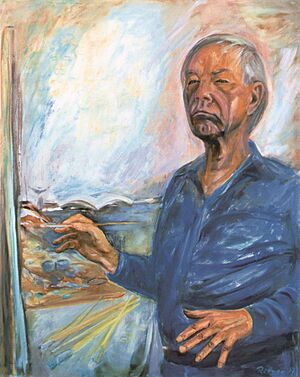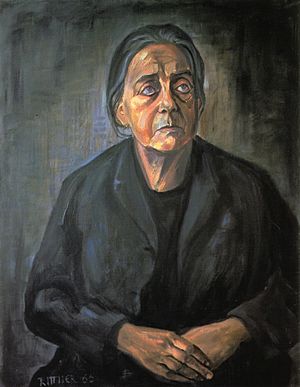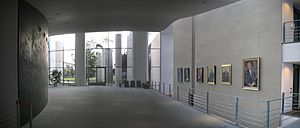Günter Rittner facts for kids
Günter Rittner (born March 11, 1927 – died November 23, 2020) was a German painter and illustrator. He is known as one of Germany's most famous portrait painters of the 20th century. Rittner painted portraits of former German Chancellors Ludwig Erhard and Kurt Georg Kiesinger. These paintings helped start the Gallery of Chancellors in 1976. This special gallery is located in the Bundeskanzleramt (the German Chancellery) in Berlin.
Contents
Günter Rittner: Life of a Painter
Early Life and Training
Günter Rittner was born in Breslau, Germany, on March 11, 1927. He started drawing portraits of his grandparents when he was only six years old. In 1939, he painted injured soldiers in a military hospital. That same year, he began taking evening classes in scenery painting. He attended the Breslau School of Fine Arts.
In 1943, Rittner won first prize in a local art competition. He won for his first self-portrait, which was an oil painting. In 1944, he was called to serve in the military. A year later, he became a prisoner of war. At first, he drew portraits of other prisoners using a borrowed pencil and toilet paper. Later, he painted the guards and even the camp commander. The commander then gave him proper art supplies.
Art Studies and Career Beginnings
After his release in 1945, Rittner earned money by painting portraits of American soldiers. This helped him pay for more art studies. In 1948, he moved to Munich, which became his second home. He studied at the Academy of Fine Arts, Munich until 1953. During this time, his art was influenced by the difficult experiences of the war. Artists like Ernst Barlach, Käthe Kollwitz, Cézanne, van Gogh, and Toulouse-Lautrec also inspired him.
In 1953, Rittner started working as a full-time artist. He traveled to Italy, France, and England to learn more about art. During these trips, he painted many cities and landscapes. His artwork was shown to the public for the first time in 1966. This exhibition took place at the Munich Deutsches Theatermuseum.
Painting Important Figures
Rittner received many requests to paint people from politics, business, and science. He painted former Chancellors Ludwig Erhard and Kurt Georg Kiesinger between 1974 and 1976. In 1975, he also painted a portrait of former German President Walter Scheel.
In 1980, Rittner got married and moved with his family to Mallorca, then to Gran Canaria. He later divorced and had one son. In 1989, he received the German Federal Cross of Merit. This is a high honor in Germany.
In 1996, Rittner painted Walter Scheel again. Scheel was an honorary citizen of the city of Solingen. Rittner donated the money he earned from this painting to a foundation for children with learning disabilities. From 1986, Rittner spent his winters in Gran Canaria. However, he always said he would never leave Munich because the city inspired him. Günter Rittner passed away in Munich on November 23, 2020, at the age of 93.
Günter Rittner: His Artwork
Günter Rittner painted many famous and important people throughout his career. In 1950, he painted Princess Pilar of Bavaria. She was a painter herself and helped him a lot. That same year, he painted George N. Shuster, a U.S. official in Bavaria. He also painted eight main actors from the Oberammergau Passion Play.
Portraits of Actors and Politicians
In the early 1950s, Rittner created drawings of famous actors like Werner Krauß, Will Quadflieg, and Hermine Körner. He also painted movie director Paul Verhoeven and actresses like Luise Ullrich and Winnie Markus. Later, he painted actors Curd Jürgens and Paul Dahlke.
Rittner also painted several Bavarian Prime Ministers. These included Fritz Schäffer, Wilhelm Hoegner, and Alfons Goppel. The Bavarian State Chancellery asked him to paint these portraits.
Scientists and Musicians
Among the important scientists Rittner painted were Feodor Lynen, a biochemist who won a Nobel Prize, and Werner Leibbrand, a medical historian. Rittner also worked with pianist Elly Ney. He felt that working with her helped him paint in a very expressive way. He said it was like a new world opened up to him.
In 1966, Rittner painted a strong portrait of Therese Giehse. She was famous for playing the main character in Berthold Brecht’s play Mother Courage and Her Children. Rittner also painted many other actors from the Munich Kammerspiele Theatre. These included Peter Lühr, Rudolf Vogel, and Fritz Kortner. He also painted the satirist Werner Finck and conductor Joseph Keilberth. Rittner donated the portrait of Keilberth to the Bavarian State Opera. He also drew the famous actor Heinz Rühmann.
Religious and Business Leaders
Rittner's work also includes portraits of important religious leaders. In 1967, he painted Martin Niemöller, a church president. In 1968, he painted Cardinal Julius Döpfner. In 1998, he created a portrait of Cardinal Friedrich Wetter for the Archdiocese of Munich and Freising.
Since 1970, Rittner received many requests from the business world. He painted famous business leaders like Otto Braun, Willy Messerschmitt, and Ludwig Bölkow.
In 1975, Rittner painted Franz Josef Strauss, a well-known politician. In 1977, he painted Hans-Jochen Vogel, who was the Lord Mayor of Munich. Rittner often used an art style called Impressionism to capture people's unique characters.
Other Inspirations
Classical music was always a big inspiration for Rittner. He listened to Mozart while painting actress Senta Berger. His favorite composers included Bach and Beethoven. When painting Therese Giehse, he listened to Anton Bruckner's 9th Symphony.
Rittner also enjoyed painting landscapes and buildings. He loved using bright colors in these works. In 1962 alone, he painted 18 scenes of Venice. He also painted famous places in Munich, such as the Munich Hofgarten, Viktualienmarkt, and the Chinese Tower in the English Garden. He even painted the famous Oktoberfest. As he got older, he started focusing more on religious topics in his art. He had painted the sufferings of Christ before, using deep black colors to show strong emotions.
Rittner once described his painting process. He said he would get so lost in his work that he wouldn't notice time passing. He would stand at his easel for more than ten hours. He felt his eyes and hands would start working on their own. He compared the feeling after painting to a prayer or meditation, bringing a sense of peace.





